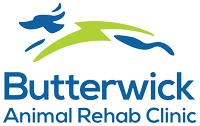Cruciate ligament injury in dogs is one of the most common injuries, and it’s often caused by exercise but most particularly rapid changes of direction at speed.
This type of damage is more likely to happen in the spring months, when a dog that has been used to gentle winter walks is suddenly given a taste of freedom on longer walks or off the lead.
However, with excess weight also being a contributor in cruciate ligament injuries, it’s important to get the balance right, between maintaining a healthy weight and not going overboard.
The key is, like always, moderation, especially in those transitional weeks and months, between doing very little and doing a lot more.
Here are a few tips for some low-impact exercises to do with your dog – think of it as preparation for the summer!
The thrill of the chase
Much as dogs love it, games of chase and fetch can unfortunately be among the worst culprits for damaging the cruciate ligament. This is because many dogs will jump, twist and turn during this game, which puts a lot of pressure on knee joints, especially if they’re already suffering a little wear and tear.
To avoid dog knee injuries, a similar activity can be performed in water – if your dog likes it, of course. However, you’ll need to choose your location carefully, avoiding steep or slippery sides/rocks, and making sure it’s not too deep or fast-flowing.
Alternatively, at our hydrotherapy pool, we play the same game: use a floating toy that your dog is particularly interested in, place it in the pool and encourage them to fetch.
The water cushions their joints, making it low impact, yet also offers gentle resistance to build up muscle strength.
Hide and seek
Whether you’re looking to avoid a cruciate ligament injury or your dog is recovering from one, a gentle game of hide and seek around the house can give them a different challenge.
Dogs love to sniff (as we know) so to keep this sense occupied without haring after another random pup on your walk, and risk any injury, you can create something closer to home.
To do this, you’ll need a few small boxes, and you’ll put their favourite treat in one of them.
Depending on how much they like to be challenged, you can either arrange them all within sight, or hide them around your house or garden.
Encourage your dog to sniff out the treat – rewarding their correct guess, of course.
The beauty of this activity is that it engages a number of your dog’s senses while also allowing them to take it easy – physically, at least.
Agility
While leaping in the air is a definite no-no when it comes to dog knee injuries, there’s no reason why you can’t create a floor-level agility course.
Weaving between cones or ducking through tunnels all work a number of different muscles, offering another way of getting some valuable exercise while reducing undue stress on joints.
Don’t worry if you don’t have all the kit. You can easily set up a rudimentary weaving course using cones, tins, bottles or (unless your dog’s a chewer) shoes. As for tunnels, channel your inner den-builder, and hang sheets and towels from chairs and tables.
Underwater treadmill
Now, we know this won’t be a piece of kit you’ve got lying around the house – but we have.
The underwater treadmill is marvellous for dogs who are taking extra care with their joints, for whatever reason.
We mainly use ours specifically for rehabilitation after injury or surgery, but it’s also a great low-impact exercise for dogs generally.
The buoyancy of the water allows your dog’s body to float, yet still move underwater, which relieves pressure from joints and ligaments. What’s more, the warm circulating water provides additional pain relief, should that be a concern.
If you’re concerned about any aspect of your dog’s mobility, get in touch with our team today. We offer a first free consultation and we always love to meet new friends – and their owners!
